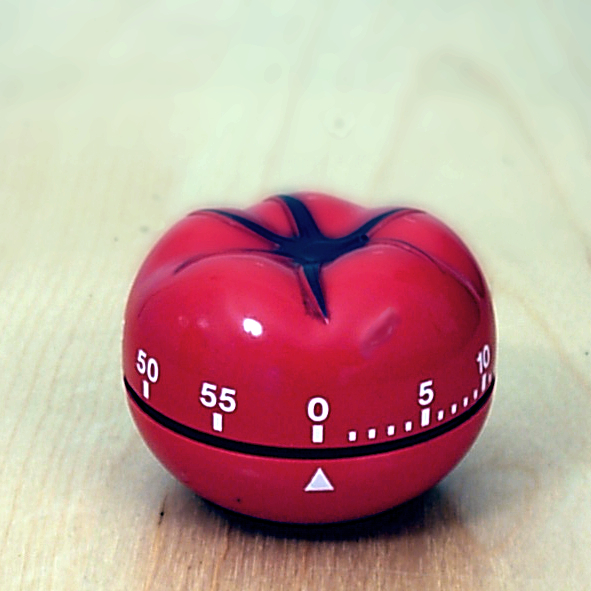Get productive with Pomodoro
This topic is also covered in a video tutorial.
The Pomodoro technique is a time management method, where you alternate between periods of work and short breaks. Usually these are 25 minutes of work followed by 5 minute breaks. Historically, a kitchen timer was used. In Italy this is called a "pomodoro" (tomato) because they're often shaped like one.

This technique was invented before computers were widely used, and has proven its value over the years. It also works well for people with desk jobs, in part because the function of the kitchen timer can easily be replaced by a simple computer program.
A few other resources to learn about Pomodoro:
- A friendly video introduction at calmcode.io
- The inventor's website
How Pomodoro works
One of the virtues of the technique is its simplicity:
- Choose a task.
- Set the timer for 25 minutes, and work on the chosen task.
- Timer goes off. Take a 5 minute break.
- Repeat.
Why it gets the work done
By actively deciding on a task, you create the mood to work on it. Because 25 minutes is short enough for most tasks to attain focus, chances are that during the 25 minutes you stay motivated and sharp.
You should, however, watch out for interruptions and distractions. Turn off as many notifications as possible (e.g. realize that email is asynchronous communication; notifications are often not necessary). Try to create an environment that allows you to stay focused.

The blocks of 25 minutes divide the work up in chunks. After each block you can celebrate your progress. The breaks introduce mental distance to the work, which helps maintain overview. This provides a feeling of control, and helps you prevent going too deep down a rabbit-hole.
Do proper breaks
It's hard to underestimate the importance of the breaks. Don't consider them as lost time (I'm guilty of that myself sometimes). The breaks provide the necessary rest for your brain to recover, so that you can maintain focus during the next 25 minutes of work. Moreover, providing time for the brain to wander freely can really boost your creativity.
It is tempting to deal with some of the "distractions" that occurred during the work. E.g. you may want to process some email. This is cheating, because this is also work! It would be better to reserve a separate 25 minute block of work to deal with these tasks.

The breaks are about not-working. If you work on a computer, it's best to leave your seat and get some movement. Visit the toilet, grab a coffee, or even better: do some breathing exercises, meditation, or physical exercises. The point is to engage in an activity that is very different from work, so that your brain gets some rest. The better your breaks, the more effective your work will be.
It can be tempting to skip a break when you're in "the flow". And maybe you should. But don't skip two in a row. Remember that it's probably because of these breaks that you were able to get into a flow in the first place.
Long breaks
As effective as the 5 minute breaks can be, they won't be enough to last through a whole day. After about 4 of these 30-minute blocks, it is recommended to have a longer break. This would be a good time to e.g. have lunch.
The effects
Some reported effects of using the Pomodoro technique are:
- More motivation and increased focus.
- Less mistakes due to working under fatigue.
- Working more effectively (work smarter, not harder).
- Less stress and risk on burnout.
Personally, Pomodoro is not a technique that I use every day. But there are these days (e.g. working from home while the whole family is at home too) that this technique really helps me get work done.

We live in a time where others may demand a lot from us, and/or where we demand a lot from ourselves. We have to guard for that. It is possible to take gratification from your work without it burning you down. Pomodoro is a tool to help with that. Paradoxically, by forcing you to take frequent breaks you will become more effective and get more done. Ultimately this more relaxed approach to work should become standard.
Pomodoro in TimeTagger
In TimeTagger the Pomodoro method is integrated with the time tracking mechanics. To start using Pomodoro, you first need to activate it in the settings. This will add a stopwatch-button just left of the record-button.

This stopwatch-button will open the Pomodoro dialog, that allows you to cycle through the faces of work and breaks.

When the timer runs out, an alarm will sound and a notification-popup will be shown.

When Pomodoro is enabled in the settings, the Pomodoro timer is started and stopped automatically as you track your time. You will probably find that your time tracking records tend to become multitudes of 30 minutes.
What about those 5 minute breaks? One could argue that if you track time for a customer project, you should only count the time actually worked. But as I said above, these breaks are important, and they make you more productive. The breaks (when done properly) support the work and as such I'd consider it billable time.
At the time of writing, TimeTagger's Pomodoro integration is new and considered experimental. If you have problems or suggestions, let it know!